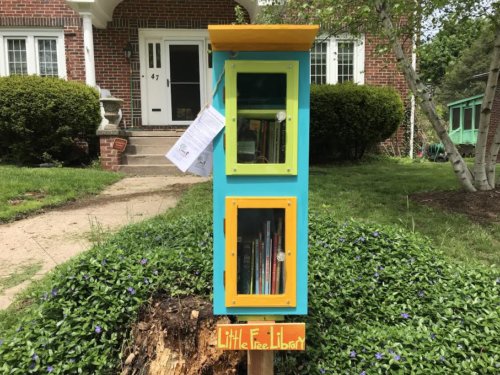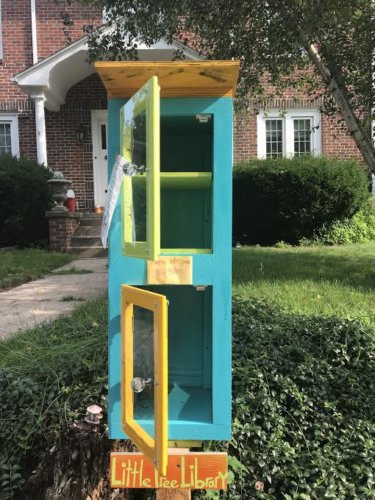
I‘ve always been a voracious reader. As a kid, it wasn’t unusual to find me snuggled deep under the covers of my bed, reading page after page under the fading glow of a dim flashlight, far after my bedtime. Now, as an adult, books are piled around our house—in shelves, on coffee tables, desks, and occasionally the dining room table. I also derive great joy in sharing my love of books with others, so when my husband and son made me my very own Little Free Library this past Mother’s Day, it filled me with joy. A chance to spread my love of books to the entire neighborhood? Yes, please!
What are they?
Little Free Libraries are popping up all over the place, and if there’s any trend I can get behind, it’s this: People either build or buy a small library set-up—a protected, weatherproof set of shelves big enough to display at least 15-20 books. The library is placed outside your home or in a neighborhood common area so people can pop by and check out books that interest them while also leaving a few of their own for the next person.
These libraries are not only a great way to help clear out some of your collection, but they can also help feed your book habit by finding new ones that pique your interest—for free!

How do you start your own?
There’s a Little Free Library website dedicated to the concept. They have a variety of different building plans if you’re up for creating one from scratch, a shop for purchasing ready-made libraries (as well as various library accessories), and a wealth of information about the ins and outs of being a Little Free Library steward.
Instead of purchasing one, my husband repurposed an old cabinet we had in the basement and replaced the wooden doors with plexiglass so you can see the books within. I helped out by spray-painting the library all sorts of bright, bold colors (I was eager to ensure that nobody missed it when they walked past). Of course, if carpentry isn’t your thing, and you don’t feel like buying a library, you can get creative and see what you already have around your home. Some have used little red wagons, milk crates, laundry baskets, and other random household objects to start off. Just keep in mind the climate where you live, and ensure that whatever you use to house your books will withstand rain, snow, heat, etc…
Top tips
Start with stellar books. While you might relish the opportunity to use your Little Free Library as a place to dump old textbooks you’re still holding on to, resist the urge! You want folks to actually partake in your library and find books that are interesting to them. That means holding off on filling it with random books you know won’t move.
I’m not suggesting you part with a signed, first edition of your favorite novel, but if you happen to have two copies of your favorite Shakespeare play or Janet Evanovich mystery, why not spread the love?
Rotate out books often. When you first get started, don’t put all of your books out at once. Save a handful to circulate into the library when current books don’t seem as popular. I keep a stack of books by my front door and will rotate what’s on offer to keep things fresh. This ensures that the same books aren’t staring people in the face month after month and helps give you an idea of what type of books people in your area enjoy (or don’t!). In our neighborhood, light “beach reads” and cookbooks seem to be big hits, as well as any type of children’s book. The former could be influenced by the season, so we’ll see if more serious books end up being hot as we move into the cooler months.
Include a conversation starter: One of the best things in our library is a little notebook with a pen attached. I wrote a note encouraging folks to leave book recommendations, a friendly greeting, or even a joke. Within a week it had been used to suggest a number of titles (some which I had in the house!) as well as some seriously good “Dad jokes.” Since there is nobody physically stationed at the library, this is a great way to make interactions with your neighbors active and to keep them interested in coming back!
Possible pitfalls
There were a few things we did not anticipate, however. Here is what has come up in the first few months of owning our Little Free Library, and how we handled it.

Ants: These critters moved in almost immediately. Nobody wants a book crawling with ants, so only days after I had placed our first books, I emptied everything out, wiped it down with a non toxic spray, and sprinkled mint all around the library, both inside it and around the post. Within a day all of the ants were gone and they have yet to return, thankfully.
Crappy donations: I’m not going to lie, a couple of my neighbors seem to be using the library as a recycling center, and while I appreciate them trying, leaving a half-filled Sudoku book or a torn-up magazine isn’t exactly the purpose of the library. I do some curating every few days, pulling the obvious junk and pop it in the actual recycling bin. Luckily, I’ve noticed that while we had significantly more crappy donations when we first started, they’ve gone down in number as the months have gone by.
Theft: This one threw us for a loop, to be honest. We come home one day to discover the library completely empty. No books, no little notepad and pen, and no laminated copy of Little Free Library info in Spanish that had fallen from its string on the front door. We couldn’t quite understand what happened. The books are free—so why would somebody take all of them at once? Our son felt violated. I just felt sad. Clearly somebody was in a bad place if they felt the need to steal a bunch of free books (to sell perhaps?). I posted about it in my neighborhood Facebook group and not even a couple hours later, the library was overflowing with new books. While this started as a pitfall, it turned into an outpouring of neighborly support, so we were able to find a silver lining.
When it comes down to it, Little Free Libraries only take up a small amount of time, but the impact they can have—encouraging readers both young and old as well as creating strong neighborhood connections—can last a lifetime!


Grok Nation Comment Policy
We welcome thoughtful, grokky comments—keep your negativity and spam to yourself. Please read our Comment Policy before commenting.